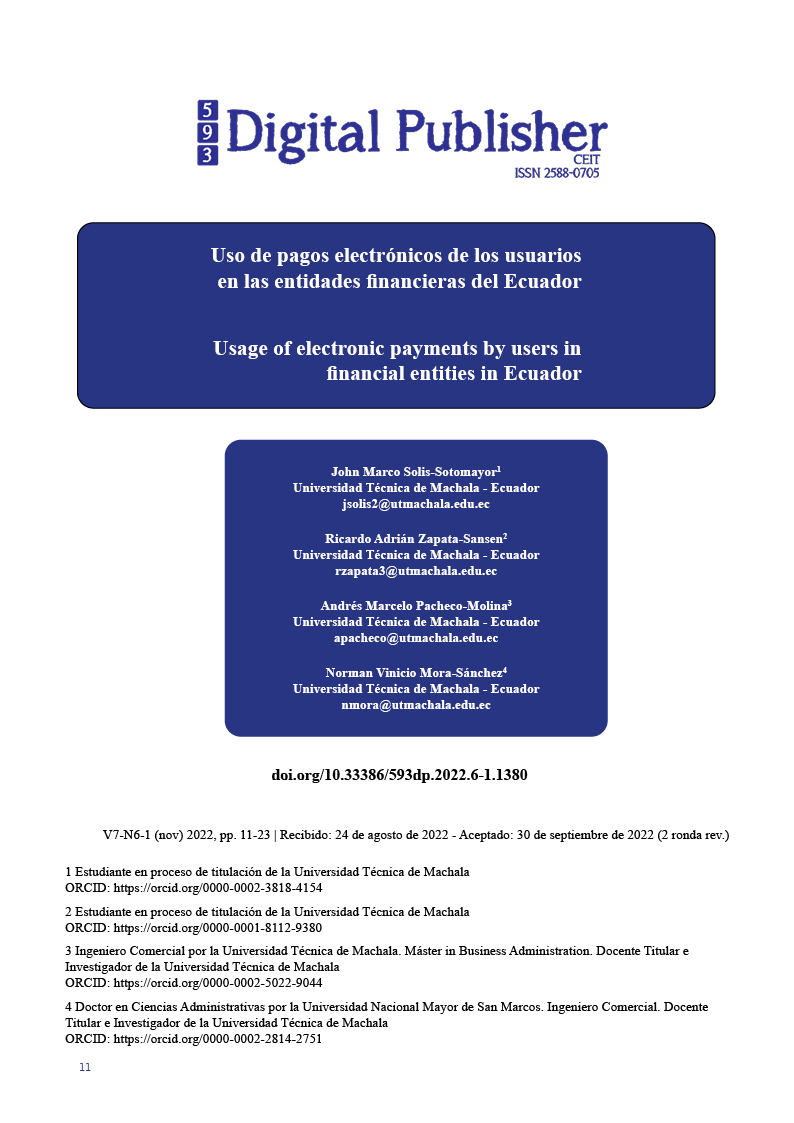Usage of electronic payments by users in financial entities in Ecua-dor
Main Article Content
Abstract
This study was driven in the province of El Oro where the probability that a user of a financial institution with certain sociodemographic conditions uses electronic payments or not for use in FinTech companies was calculated. The model used for this research was Binary Logistic Regression (LR), using an analysis carried out with the statistical program SPSS. It was found that people who work in Machala are 64% more likely to use electronic payments with respect to users who work in other cities, and people with incomes greater than $ 155 are 1.6 times more likely to use electronic payments. Two groups of variables were taken into account: the significant ones, which were obtained from the people who work in Machala and, on the other hand, the qualitative variables, which correspond to the users who have greater facility in the use of electronic payments.
Downloads
Article Details

This work is licensed under a Creative Commons Attribution-NonCommercial-ShareAlike 4.0 International License.
1. Derechos de autor
Las obras que se publican en 593 Digital Publisher CEIT están sujetas a los siguientes términos:
1.1. 593 Digital Publisher CEIT, conserva los derechos patrimoniales (copyright) de las obras publicadas, favorece y permite la reutilización de las mismas bajo la licencia Licencia Creative Commons 4.0 de Reconocimiento-NoComercial-CompartirIgual 4.0, por lo cual se pueden copiar, usar, difundir, transmitir y exponer públicamente, siempre que:
1.1.a. Se cite la autoría y fuente original de su publicación (revista, editorial, URL).
1.1.b. No se usen para fines comerciales u onerosos.
1.1.c. Se mencione la existencia y especificaciones de esta licencia de uso.
References
Arango, C., Ramírez, A., & Restrepo, M. (2022). Person-to-business Instant payments: could they work in Colombia? www.henrystewartpublications.com/jpss
Arauz, A., Garratt, R., & Ramos F., D. F. (2021). Dinero Electrónico: The rise and fall of Ecuador’s central bank digital currency. Latin American Journal of Central Banking, 2(2), 100030. https://doi.org/10.1016/j.latcb.2021.100030
Aurazo, J., & Vega, M. (2021). Why people use digital payments: Evidence from micro data in Peru. Latin American Journal of Central Banking, 2(4), 100044. https://doi.org/10.1016/j.latcb.2021.100044
Campuzano, J., Chávez, G., & Maza, J. (2018). El fracaso del dinero electrónico en Ecuador. 7(3), 82–101. https://doi.org/10.177993/3cemp.2018.070335.82-101/84
Daragmeh, A., Lentner, C., & Sági, J. (2021). FinTech payments in the era of COVID-19: Factors influencing behavioral intentions of “Generation X” in Hungary to use mobile payment. Journal of Behavioral and Experimental Finance, 32. https://doi.org/10.1016/j.jbef.2021.100574
Donoso, M. (2022). ¿Cuán importante es la seguridad cibernética para lograr la seguridad hídrica? Revista de Ciencias Ambientales, 56(1), 284–297. https://doi.org/10.15359/rca.56-1.15
Eriksson, N., Gökhan, A., & Stenius, M. (2021). A qualitative study of consumer resistance to mobile payments for in-store purchases. Procedia Computer Science, 181, 634–641. https://doi.org/10.1016/j.procs.2021.01.212
Espinosa, M., & Armijos, V. (2021). La transformación digital y su incidencia en el e-commerce en Ecuador. 169–174. https://doi.org/10.54808/CICIC2022.01.169
Fu, J., & Mishra, M. (2022). Fintech in the time of COVID−19: Technological adoption during crises. Journal of Financial Intermediation, 50, 100945. https://doi.org/10.1016/j.jfi.2021.100945
Jiménez, O., Jaramillo, L., & Salcedo, V. (2022). Tendencias digitales: diagnóstico de aplicación en PYMES en la Ciudad de Machala, Ecuador Postpandemia. Dilemas Contemporáneos: Educación, Política y Valores., 1–23.
Jocevski, M., Ghezzi, A., & Arvidsson, N. (2020). Exploring the growth challenge of mobile payment platforms: A business model perspective. Electronic Commerce Research and Applications, 40. https://doi.org/10.1016/j.elerap.2019.100908
Karsen, M., Chandra, Y. U., & Juwitasary, H. (2019). Technological factors of mobile payment: A systematic literature review. Procedia Computer Science, 157, 489–498. https://doi.org/10.1016/j.procs.2019.09.004
Kutubi, A., Alam, K., & Morimoto, Y. (2021). A simplified scheme for secure offline electronic payment systems. High-Confidence Computing, 1(2), 100031. https://doi.org/10.1016/j.hcc.2021.100031
León, C., & Ortega, F. (2018). Nowcasting economic activity with electronic payments data: A predictive modeling approach. Revista de Economia Del Rosario, 21(2), 381–407. https://doi.org/10.12804/revistas.urosario.edu.co/economia/a.7205
Mediomundo, C. (2022). EL ECOSISTEMA FINTECH (TECNOLOGÍA FINANCIERA) COMO. Revista Gestión I + D, 7, 12–39. https://dialnet.unirioja.es/servlet/articulo?codigo=8255368
Nelloh, L., Santoso, A., & Slamet, M. (2019). Will users keep using mobile payment? It depends on trust and cognitive perspectives. Procedia Computer Science, 161, 1156–1164. https://doi.org/10.1016/j.procs.2019.11.228
Pereira, A., & Pedreschi, M. (2022). ACCESO Y USO DE MEDIOS TECNOLÓGICOS BANCARIOS_ FACTOR RELEVANTE EN LA BANCARIZACIÓN DE LA POBLACIÓN UNIVERSITARIA DEL DISTRITO DE CHITRÉ, HERRERA, PANAMÁ, 2018-2019. Revista Colegiada de Ciencia, 3, 19–35. http://portal.amelica.org/ameli/journal/334/3342999003/3342999003.pdf
Quintero, J., & Mejía, M. (2021). Factores asociados a la adopción de la banca electrónica en México. Revista Mexicana de Economía y Finanzas, 17(2), 1–23. https://doi.org/10.21919/remef.v17i2.659
Rubio, J., Pérez, B., Acosta, D., & Arroyo, J. (2021). Preferencias en el uso de pagos electrónicos en el Ecuador. CUESTIONES ECONOMICAS, 31, 1–25. https://doi.org/10.47550/rce/31.1.3
Sasongko, D., Handayani, P., & Satria, R. (2022). Analysis of factors affecting continuance use intention of the electronic money application in Indonesia. Procedia Computer Science, 197, 42–50. https://doi.org/10.1016/j.procs.2021.12.116
Szumski, O. (2020). Digital payment methods within polish students -leading decision characteristics. Procedia Computer Science, 176, 3456–3465. https://doi.org/10.1016/j.procs.2020.09.051
Wu, J., Jiangong, N., Wu, Z., & Jiang, H. (2021). Early warning of risks in cross-border mobile payments. Procedia Computer Science, 183, 724–732. https://doi.org/10.1016/j.procs.2021.02.121
Yan, L. Y., Tan, G. W. H., Loh, X. M., Hew, J. J., & Ooi, K. B. (2021). QR code and mobile payment: The disruptive forces in retail. Journal of Retailing and Consumer Services, 58. https://doi.org/10.1016/j.jretconser.2020.102300
Zhu, Q., Liu, B., Han, F., & Lee, M. (2020). The optimization effect of fuzzy factional-order ordinary differential equation in block chain financial cross-border E-commerce payment mode. Alexandria Engineering Journal, 59(4), 2839–2847. https://doi.org/10.1016/j.aej.2020.06.031





